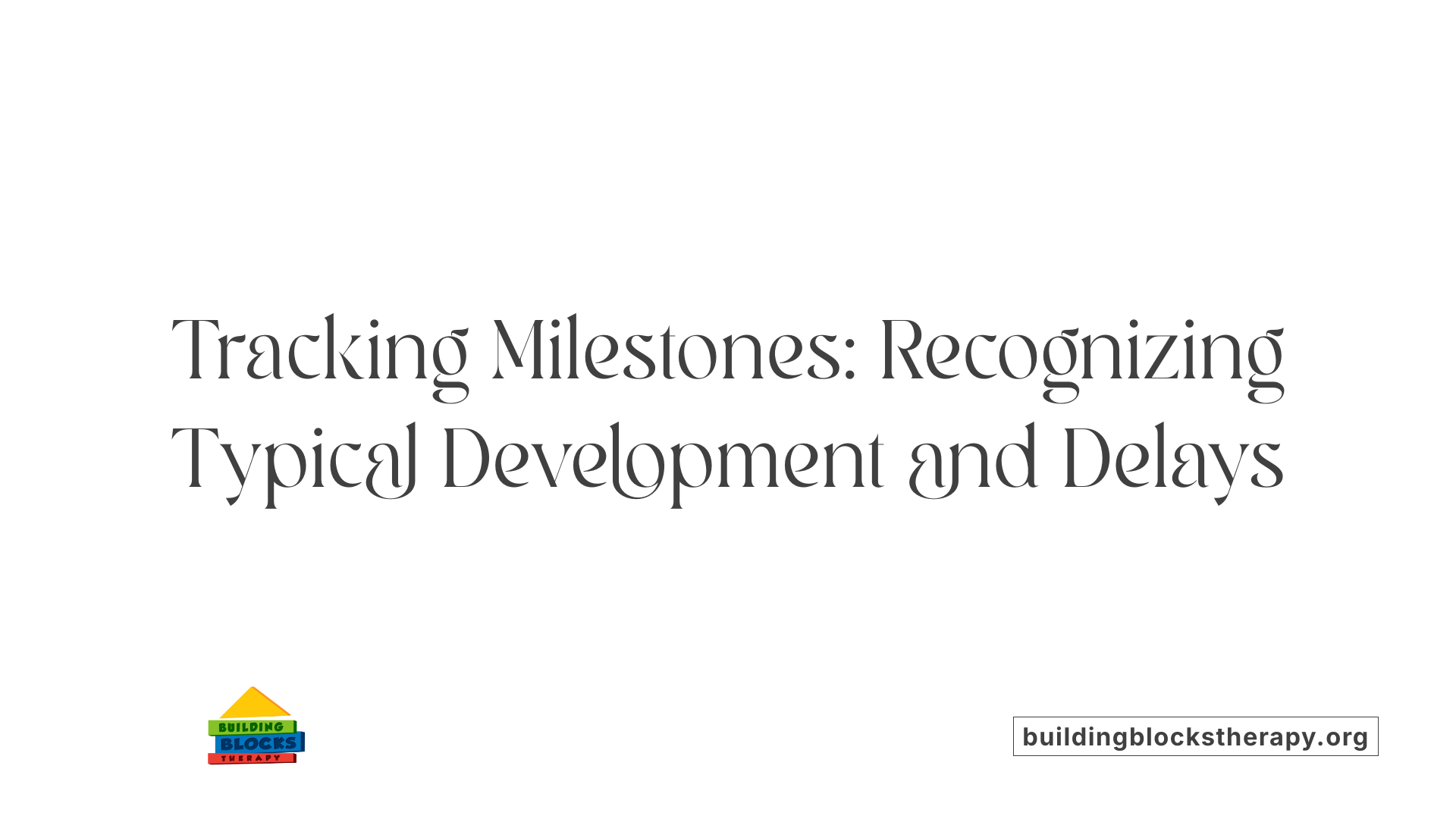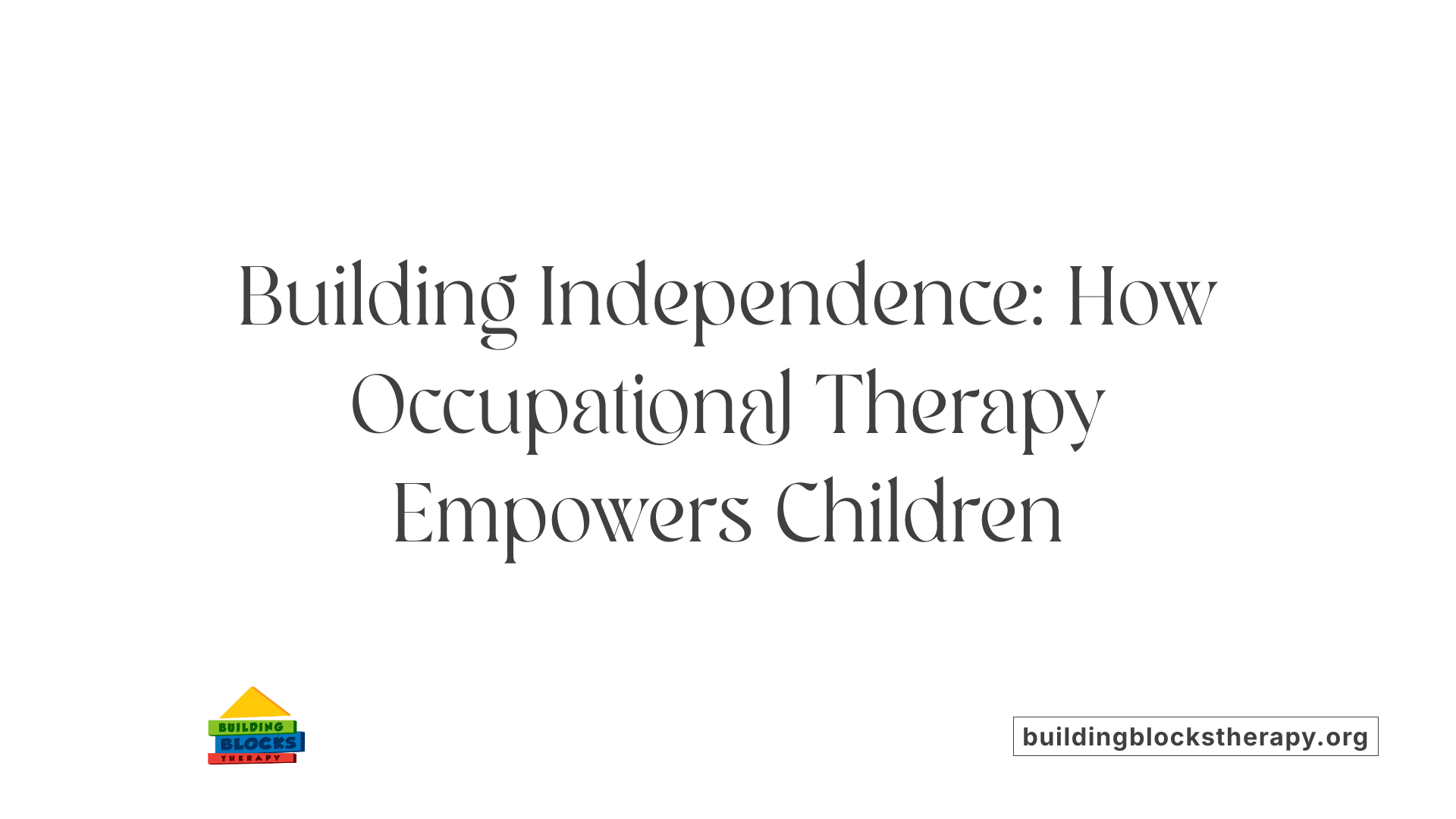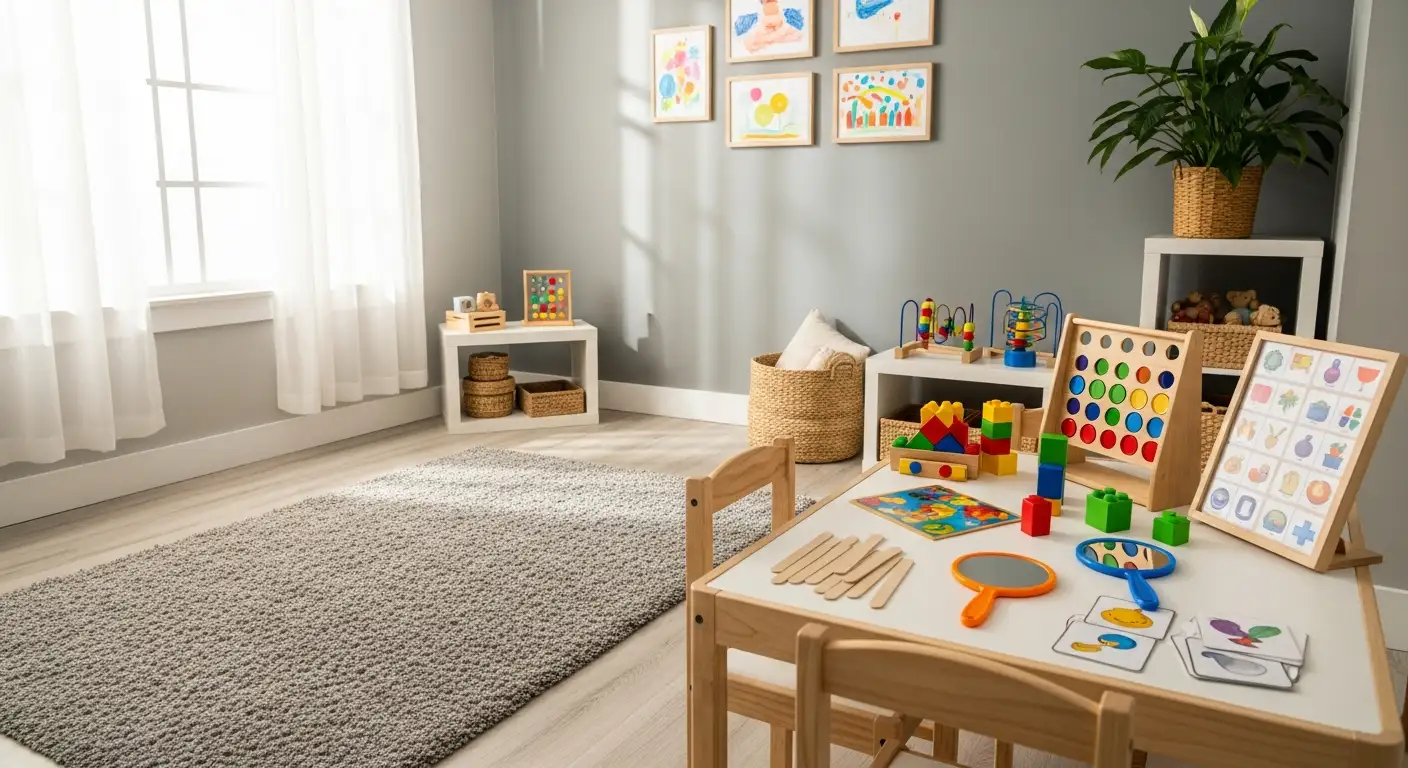Understanding and Addressing Fine Motor Skill Challenges in Children
Fine motor skills are fundamental for a child's independence, academic success, and social participation. These small muscle movements—ranging from grasping a pencil to tying shoelaces—develop gradually from birth through childhood. When delays or difficulties occur, targeted therapy, particularly occupational therapy (OT), plays a critical role in helping children overcome these challenges. This article explores how therapy supports fine motor development, the methods and activities used, developmental milestones and signs of delays, the effectiveness of interventions, and how tailored strategies foster independence and confidence.
The Role of Occupational Therapy in Enhancing Fine Motor Skills

What is the role of occupational therapy in improving fine motor skills in children?
Occupational therapy (OT) is a crucial support system for children experiencing challenges with fine motor skills. These skills involve small muscle movements of the hands, fingers, and wrists, essential for everyday tasks such as writing, buttoning, eating, and self-care activities. Therapists evaluate each child's unique needs through comprehensive assessments, which include observing motor development, strength, coordination, sensory processing, and visual-motor integration.
Following evaluation, occupational therapists develop tailored intervention plans focused on fostering independence and confidence. Interventions often incorporate play-based activities that children find engaging and meaningful. These might include drawing to improve grasp and control, cutting with scissors to enhance hand-eye coordination, threading beads to develop dexterity, and practicing with tools like tongs or tweezers to refine pinching strength.
A key component of OT is sensory integration therapy, which aims to improve a child's sensory processing abilities. Sensory activities such as squeezing therapy putty, pulling small objects, or engaging with textured materials support sensory modulation and body awareness, foundational for precise small muscle movements.
Therapists also utilize adaptive equipment—like pencil grips, slanted writing surfaces, or weighted utensils—to facilitate proper grip and control. These tools help children perform tasks more effectively and comfortably, fostering independence.
Collaboration is vital for sustained progress. Occupational therapists work closely with parents, teachers, and caregivers to incorporate fine motor activities into daily routines, whether at home, school, or in community settings. They provide strategies, demonstrations, and modifications to support skill development.
Throughout therapy, progress is monitored using specific work samples, assessments, and ongoing feedback. Celebrating small achievements motivates children and encourages continued effort.
Structured, goal-oriented play activities are especially effective. For example, children might practice manipulating small objects, engaging in crafts, or completing puzzles. These activities target specific skills like grasp strength, bilateral coordination, and visual-motor integration.
Most programs span approximately 15 weeks with regular sessions designed to be fun and engaging, often lasting about 45 minutes, twice a week. Adjustments are made based on each child’s needs, resources, and environment to optimize outcomes.
When working with children who have developmental delays or neurological conditions such as cerebral palsy, Down syndrome, or sensory processing disorder, OT employs specialized techniques to address underlying issues impacting fine motor development.
In-home therapy options offer caregivers the opportunity to practice targeted exercises and strategies within the child's natural environment, helping integrate skill-building into daily life.
Overall, occupational therapy supports children in building the small muscle control necessary for academic tasks, self-care, and social participation. By focusing on individualized, playful, and functional activities, OT enhances children's ability to perform everyday activities with greater ease and independence.
Effective Activities and Techniques for Developing Fine Motor Skills

What are effective methods and activities to develop fine motor skills in children?
Developing fine motor skills in children can be successfully supported through a combination of engaging, everyday routine activities and targeted exercises. These activities encourage small, precise hand movements crucial for tasks like writing, dressing, and manipulating objects.
Children benefit from activities such as peeling stickers, stringing Cheerios, threading beads, and placing coins into piggy banks. Using clothespins to attach or clip items also promotes finger strength and dexterity. Such tasks are simple to incorporate into daily routines and are enjoyable for children, encouraging consistent practice.
Strengthening exercises play a vital role in developing control and strength in small muscles. Therapists and parents often recommend squeezing playdough or stress balls, using tweezers or eye droppers, and pressing leaves or small objects onto paper with paint or ink. These activities enhance muscle tone and coordination.
To improve hand-eye coordination and spatial awareness, children can engage in puzzles, maze activities, and coloring within lines. Cutting activities, starting with age-appropriate tasks, contribute significantly to precision. Initially, children can cut along thick lines; as their skills improve, they can progress to more complex patterns.
Scissor skills evolve gradually. Younger children might begin by snipping paper with safety scissors, while older children can work on cutting across straight, curved, and zigzag lines. Tips like taping down the paper or using thicker sheets help children achieve cleaner cuts and build confidence.
In addition to fine motor activities, gross motor skills and bilateral coordination exercises support overall motor development. Activities such as balancing on a beam, jumping, or crawling through obstacle courses improve core strength and coordination, which indirectly benefit fine motor control.
Here are some effective strategies summarized in a table:
| Activity Type | Examples | Development Focus |
|---|---|---|
| Routine tasks | Peeling stickers, attaching clothespins, buttoning | Finger dexterity and grip strength |
| Strengthening exercises | Squeezing playdough, using tweezers, pressing leaves | Muscle strength and control |
| Precision activities | Puzzles, coloring, cutting along lines | Hand-eye coordination and fine control |
| Scissor skill development | Cutting various shapes, zigzags | Cutting accuracy and hand control |
| Gross and bilateral activities | Balancing, jumping, crawling | Core stability and coordination |
Combining these activities into children’s daily routines and playtime ensures progressive development of fine motor skills. Consistent practice, coupled with step-by-step progression in complexity, helps children gain confidence and independence in everyday tasks.
Early assessment and intervention by occupational therapists can tailor activities to a child's specific needs, making use of adaptive tools and strategies. Ultimately, engaging and enjoyable activities foster a positive experience, motivating children to develop the fine motor skills necessary for academic success and daily independence.
Milestones and Indicators of Fine Motor Development and Delays
What are developmental milestones and signs indicating delays in children's fine motor skills?
Developmental milestones serve as important markers of typical growth in fine motor skills, showing how children develop the ability to coordinate small muscles in their hands and fingers over time. These milestones are age-specific, with early signs appearing within the first year, and more refined skills emerging as children grow.
In infants, milestones include grasping or holding toys by around 3 to 6 months, transferring objects between hands, and bringing hands to the mouth. As they approach toddlerhood (around 12 months), children typically begin to develop the pincer grasp—using thumb and forefinger to pick up small objects—and start manipulating toys with increasing dexterity.
Preschool-aged children are expected to perform more complex activities like drawing circles and lines, cutting with safety scissors, stacking blocks, and beginning to write letters and words. By age 5, most children can tie shoelaces, fasten buttons, and write legible sentences.
Signs suggesting potential delays in fine motor development include persistent difficulty with these milestones. These can manifest as trouble manipulating small objects like coins or buttons, poor hand-eye coordination, or an inability to develop a functional pincer grasp. Children with delays may appear clumsy, frequently dropping objects or struggling with tasks that require precision.
Limited finger dexterity can interfere with everyday activities such as dressing, feeding, or coloring. For example, they might have trouble holding utensils properly, turning pages in a book, or drawing shapes.
Other signs to watch for include walking on tiptoes, appearing uncoordinated, and having difficulty with chewing or swallowing. These signs can indicate underlying neurological or sensory issues that need assessment.
Early detection of these delays is crucial because it allows for timely intervention, which can significantly improve outcomes. Parents are encouraged to seek evaluation from healthcare professionals when they notice persistent concerns, as early therapy can support children's development of essential skills and promote greater independence.
The Effectiveness of Therapy in Improving Fine Motor Skills
How effective is therapy in enhancing fine motor skills in children?
Occupational therapy plays a crucial role in improving fine motor skills among children, with numerous studies supporting its effectiveness. Evidence shows that structured, engaging interventions can lead to substantial gains in coordination, strength, and dexterity. Therapists employ activities like manipulating small objects, threading beads, and using tools such as scissors and tweezers to promote hand-eye coordination and bilateral movement.
The use of playful, activity-based techniques not only makes therapy enjoyable but also more effective. Children are more motivated during fun tasks such as craft projects, puzzles, and sensory play, facilitating better engagement and skill acquisition. By focusing on real-life functions—like buttoning shirts, zipping zippers, or using utensils—therapy influences daily independence.
Beyond the activities themselves, the frequency of sessions significantly impacts outcomes. Regular sessions, typically twice a week over several months, reinforce skills and promote steady improvement. Studies suggest that a typical program lasting around 3 to 4 months, with about 45 minutes per session, can produce meaningful progress.
Parental involvement adds another layer of success. When caregivers are engaged, they can reinforce skills through daily routines, ensuring skills are practiced in natural settings. This consistency accelerates the generalization of skills from therapy sessions to home and school activities.
Role of repetitive, play-based activities
Repetition and fun are foundational in therapy for fine motor development. Through repetitive activities such as squeezing therapy putty, popping bubble wrap, or stringing beads, children build strength and refine their movements. These exercises enhance muscle endurance and coordination, which are critical for mastering complex tasks.
Play-based activities also develop sensory integration, supporting children with sensory processing challenges that often affect fine motor control. Sensory-rich tasks help children interpret touch, vision, and proprioception more effectively, leading to improved control.
Importance of session frequency and parental involvement
Optimal results are achieved when therapy sessions are consistent and integrated into daily life. Many programs recommend sessions twice weekly for around 12 to 16 weeks. This schedule balances skill development and prevents fatigue.
Equally important is active parental involvement. Parents can carry out simple exercises and activities taught by therapists, such as practicing grasp patterns or using adaptive tools. This ongoing practice enhances skill retention and confidence.
General outcomes such as improved handwriting, self-care, and tool use
Children who participate in focused occupational therapy exhibit noticeable improvements in essential areas. Enhanced handwriting clarity, better self-care abilities (such as buttoning jackets or using utensils), and more precise tool use are common gains.
Furthermore, development in these areas promotes overall independence and self-esteem. As children master daily tasks, they become more confident in their abilities, fostering motivation for further skill-building.
In summary, therapy is highly effective in strengthening fine motor skills in children. Its success hinges on engaging, repetitive activities, appropriate session frequency, and active parental participation. These combined efforts result in meaningful improvements that support children's daily functioning, academic performance, and overall independence.
Developmental Milestones and Their Significance

What are developmental milestones and signs indicating delays in children's fine motor skills?
Developmental milestones serve as benchmarks that indicate typical progress in a child's growth and movement abilities. For fine motor skills, these milestones include a variety of actions that children typically achieve at specific ages.
In infancy, milestones start with reflexes such as grasping, which usually appears around 3 to 4 months. As children grow into their toddler years, they begin transferring objects between hands, holding small toys, and using their fingers to explore.
By age 1, most children can pick up small objects using a pincer grasp, and they start to develop the ability to manipulate utensils and turn book pages. During preschool years (ages 3-5), children refine their skills by drawing shapes, cutting with scissors, and starting to write letters.
Signs that suggest delays in fine motor development include persistent difficulty grasping or releasing objects, poor hand-eye coordination, trouble buttoning clothes, and limited finger dexterity. For instance, a child who cannot stack blocks or use a spoon by age 2 may be experiencing delays.
Other warning signs involve clumsiness, such as frequently dropping items or walking on tiptoes, and problems with chewing or swallowing. These can point to underlying neurological or sensory issues.
Early detection of such challenges is crucial. When parents or caregivers notice ongoing struggles with basic actions like pinching, grasping, or using cutlery, consulting a healthcare professional like an occupational therapist is recommended. This early intervention allows for targeted therapy that can help improve skills, increase independence, and prevent further difficulties.
In summary, developmental milestones provide a timeline for expected skill progression, and awareness of signs indicating delays can lead to prompt support, significantly benefiting a child's overall growth and daily functioning.
Strategies and Environmental Modifications to Support Fine Motor Development

What are adaptive strategies for children with difficulties?
Children facing challenges with fine motor skills can benefit from a variety of adaptive strategies designed to make tasks more manageable. These include stabilizing objects during activities (such as using non-slip mats), enlarging or extending objects to improve grip, simplifying tasks to reduce complexity, and using visual cues or prompts to guide movements. Such strategies aim to reduce frustration and encourage independence.
How are assistive devices and tools utilized?
Assistive tools play a significant role in supporting children with fine motor deficits. Items like button hooks, zipper pulls, specialized scissors, and weighted utensils help facilitate tasks like dressing and eating. Pencil grips, slanted writing surfaces, and ergonomic tools also assist children in maintaining proper posture, grip, and control, making daily routines smoother and enabling greater participation.
What modifications can be made in classrooms and homes?
In both settings, environmental modifications are crucial. In the classroom, arranging desks to promote upright sitting, providing appropriate lighting, and organizing materials for easy access can support fine motor development. Home modifications may include organizing craft supplies within reach, using large space to practice activities, and implementing routines that incorporate fine motor challenges, like buttoning shirts or drawing.
How can therapy activities be linked to daily routines?
Connecting therapy exercises to everyday tasks enhances their relevance and effectiveness. For example, practicing threading beads during snack preparation, cutting paper while following a story, or using utensils during meal times helps children apply new skills in familiar contexts. This integration fosters confidence, promotes consistency, and accelerates progress toward independence.
What is the role of occupational therapy in supporting fine motor skills?
Occupational therapists are instrumental in improving children’s fine motor abilities through personalized, activity-based interventions. They assess each child's specific needs, focusing on aspects like muscle strength, coordination, and sensory processing. Therapy sessions often include play-based activities such as squeezing therapy putty, stringing beads, or manipulating small objects which target improved grip, dexterity, and bilateral coordination.
Therapists employ sensory integration techniques when sensory sensitivities interfere with motor development. They provide adaptive equipment tailored to individual needs, like pencil grips or weighted utensils, to facilitate better hand control. These interventions are designed to build skills necessary for academic tasks such as handwriting, as well as daily activities like dressing and feeding.
Further, occupational therapists collaborate closely with families and educators to embed fine motor tasks into daily routines, encouraging consistent practice and progress. The goal of these interventions is to enhance confidence and independence, enabling children to participate fully in school, play, and self-care activities.
This comprehensive approach ensures that children with fine motor difficulties develop the small muscle control, coordination, and sensory processing skills essential for their overall growth and everyday functioning.
How do environmental modifications support fine motor development?
Environmental adjustments create an conducive space for children to practice and refine their fine motor skills. In schools, adjustable desks, accessible materials, and visual aids promote better posture and easier manipulation of objects. In homes, organized stations for arts and crafts, accessible toy storage, and ergonomic seating encourage children to engage regularly in fine motor activities.
Adaptations such as using wider handles on utensils or tools, enlarging buttons or switches, and installing visual prompts further assist children. These modifications reduce physical and cognitive barriers, fostering a more inclusive environment where children can thrive and build confidence in their abilities.
Why is linking therapy to daily routines important?
Incorporating therapy-based activities into daily routines enhances skill generalization and motivation. When children practice tasks like buttoning shirts or cutting paper during regular activities, they see the relevance of their skills and are more likely to persist.
This approach also provides consistent opportunities for reinforcement, making improvements more sustainable. For instance, practicing handwriting while doing homework or threading beads during free play makes the learning process natural and enjoyable.
Overall, aligning therapeutic activities with everyday routines supports continuous development, encourages independence, and helps children achieve functional mastery of their fine motor skills.
The Significance of Early Detection and Multidisciplinary Approaches
What are developmental milestones and signs indicating delays in children's fine motor skills?
Developmental milestones serve as benchmarks to assess a child's growth in fine motor skills. Typically, by 3 months of age, babies can bring their hands to their mouths, and by 6 months, they begin holding and transferring toys between hands. Between 6 to 9 months, children usually develop the pincer grasp—picking up small objects with thumb and forefinger—while by 9 to 12 months, they can pick up and manipulate objects with greater precision.
As children approach the preschool years, they start drawing shapes, stacking blocks, and using utensils effectively. Skills like cutting with scissors and writing are expected between ages 3 and 5.
Signs of delays in these milestones include difficulty grasping or manipulating small objects, poor hand-eye coordination, trouble buttoning clothing, and limited finger dexterity. If a child shows persistent trouble with tasks such as using utensils, drawing, or dressing, it could indicate underlying issues.
Other red flags are walking on tiptoes, appearing clumsy or uncoordinated, and challenges with chewing or swallowing. These signs may be associated with neurological, sensory, or environmental factors. Early detection of such delays is crucial, as it allows for timely intervention to support the child's development.
Parents and caregivers should seek professional guidance if they notice ongoing difficulties. Healthcare professionals, often occupational therapists, can assess and identify potential delays early on, which is vital for developing effective strategies to improve fine motor skills and foster independence.
Why is early assessment important?
Detecting fine motor delays early increases the chances of successful intervention. Early assessment helps identify whether a child's struggles stem from conditions such as developmental coordination disorder, cerebral palsy, or sensory processing issues. Recognizing problems early enables tailored therapy plans that focus on developing strength, coordination, and sensory integration, leading to improved functional abilities.
How do healthcare professionals and specialists contribute?
A multidisciplinary team commonly includes occupational therapists, physiotherapists, speech-language pathologists, pediatricians, and educators. Occupational therapists play a central role by evaluating fine motor skills, identifying areas of difficulty, and designing activities that promote precision, strength, and coordination.
Within their assessments, specialists analyze motor planning, sensory processing, visual-motor integration, and cognitive skills. They may observe a child's ability to grasp, manipulate objects, or perform tasks like buttoning or writing.
Interventions are then customized to each child's needs, often involving activities that are engaging and relevant to everyday routines, such as drawing, cutting, or dressing.
The importance of collaborative support
Successful development relies on the combined efforts of healthcare providers, educators, and families. Therapists often collaborate with teachers and parents to incorporate activities into daily routines, ensuring consistency and reinforcing skills.
Adaptive strategies and environmental modifications are also part of a comprehensive approach. For example, tools like pencil grips, adaptive scissors, or specialized utensils can aid children with fine motor difficulties.
Monitoring progress through regular assessments helps adjust interventions as needed. Celebrating small improvements boosts confidence and motivation, encouraging children to continue practicing essential skills.
In conclusion, recognizing early signs of fine motor delays and engaging a multidisciplinary team ensures comprehensive support. This collaborative effort is crucial for helping children develop independence, participate fully in daily activities, and achieve their full potential.
Enhancing Daily Functioning and Promoting Independence Through Therapy

How does therapy improve self-care skills like dressing and feeding?
Occupational therapy plays a vital role in helping children develop essential self-care skills such as dressing and feeding. Therapists assess a child's current abilities and design individual plans that incorporate engaging activities like buttoning shirts, zipping zippers, using utensils, and pulling socks.
Through repetitive practice with adaptive tools—like zipper pulls, button hooks, and weighted utensils—children learn to perform these tasks more independently. Therapy sessions often involve play-based exercises that mimic everyday routines, making learning fun and motivating.
By strengthening hand muscles, improving hand-eye coordination, and enhancing motor planning, children gradually master these skills. Parental participation is encouraged to reinforce techniques at home, fostering confidence and independence.
How does therapy evaluate and support academic activities such as handwriting?
Developing fine motor skills is crucial for academic success, especially handwriting. Occupational therapists focus on improving pencil grip, control, and letter formation through targeted exercises like tracing, copying shapes, and practicing writing.
Therapists use specialized tools such as pencil grips, slanted writing surfaces, and visual aids to facilitate learning. They incorporate activities like squeezing therapy putty, threading beads, and connecting dots to strengthen finger and hand muscles.
These interventions aim to enhance visual-motor integration, spatial awareness, and concentration. As children gain better control and confidence, their handwriting becomes more legible, leading to greater participation and success in classroom activities.
How do therapy and activities support play and extracurricular pursuits?
Play is at the core of fine motor development. Occupational therapy includes a range of activities tailored to children's interests—such as building with blocks, cutting paper, or crafting—helping to improve precision, coordination, and bilateral hand use.
Involvement in extracurricular activities like playing musical instruments, drawing, or sports can further develop fine motor skills. Therapists often incorporate these pursuits into therapy sessions, emphasizing skills needed for these activities.
For example, playing a musical instrument involves finger dexterity and hand coordination, while sports require balance and controlled movements. Adaptive strategies, such as enlarging small objects or using assistive devices like tweezers or grips, facilitate participation.
Effectiveness of therapy in improving fine motor skills in children
Therapy, especially occupational therapy, is highly effective in enhancing fine motor skills in children. It employs engaging, play-based methods that focus on coordination, strength, and dexterity.
Activities like manipulating small objects, crafting, puzzles, and sensory play improve hand-eye coordination and bilateral movement. The success of these interventions increases with consistent sessions that integrate peer interaction and functional goals, such as self-care tasks.
Parental involvement and the integration of activities into daily routines further support skill acquisition and generalization. Studies show that tailored occupational therapy programs, especially those with structured, goal-driven, playful exercises, significantly boost children’s fine motor abilities. Overall, therapy not only improves motor performance but also fosters greater independence and confidence in everyday activities.
Fostering Independence Through Tailored Interventions
Effective therapy, especially occupational therapy, plays a pivotal role in helping children develop and refine their fine motor skills. Through personalized, engaging activities and collaborative efforts with families and educators, children can overcome delays and achieve developmental milestones. Early assessment and intervention are essential for optimal outcomes, enabling children to participate confidently in daily activities, excel academically, and enjoy a greater sense of independence and self-esteem. With continued support and appropriate strategies, children with fine motor deficits can thrive and fully engage in their world.
References
- Fine Motor Skills: What They Are, Development & Examples
- Fine Motor Difficulties | Problems we help - OT for Kids
- The Role of OT in Developing Fine Motor Skills - Sasco River Center
- Motor skill intervention for pre-school children: A scoping review - PMC
- How Occupational Therapy Helps with Fine Motor Skills - More to Say
- Top Fine Motor Occupational Therapy Strategies for Kids - Coral Care
- Fine Motor Skills Therapy - Care Options for Kids






